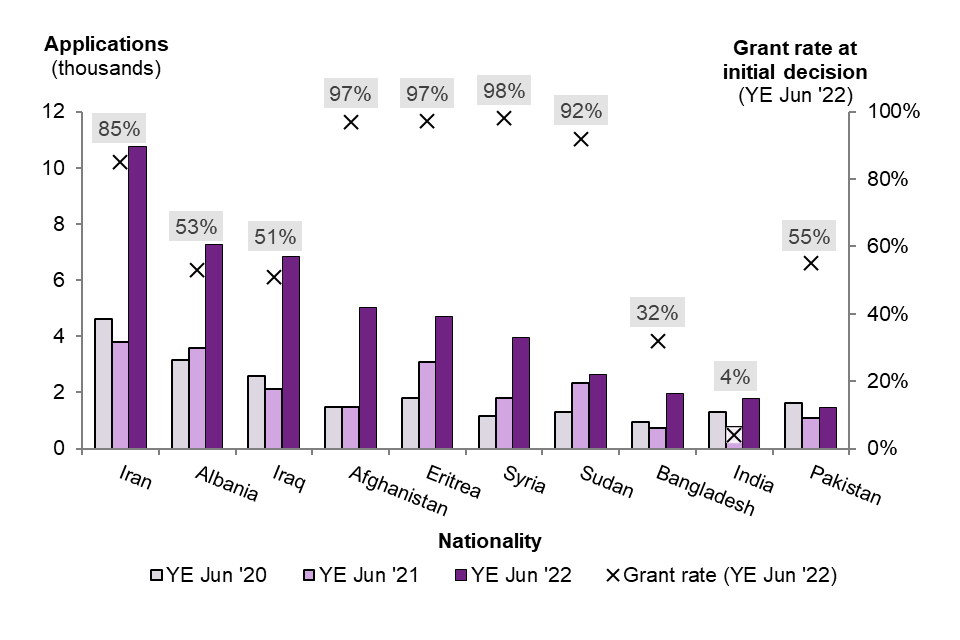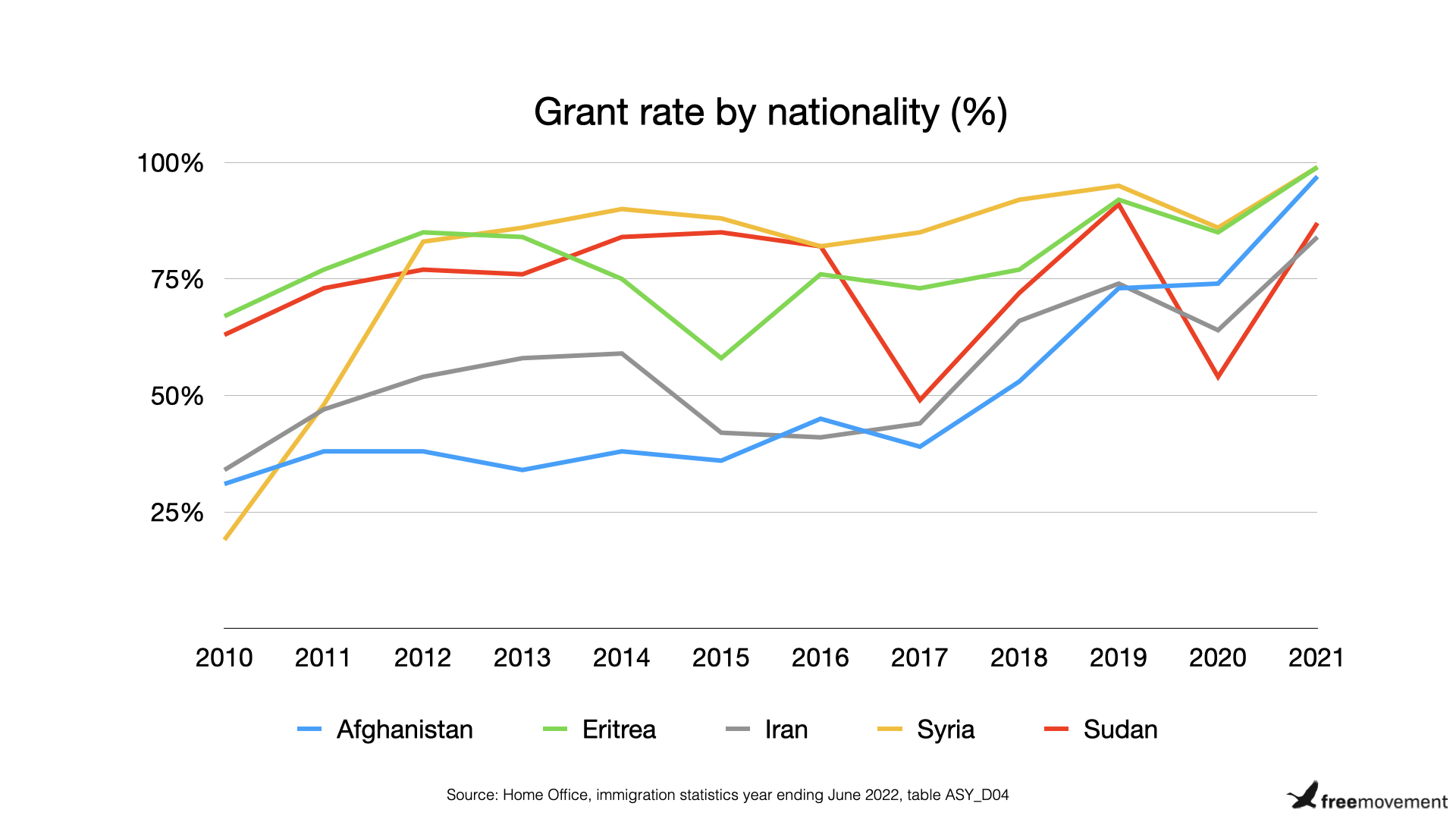- BY Colin Yeo

Why has the asylum success rate gone up so much in recent years?
Table of Contents
ToggleIt is now twenty two years since I first started work as an asylum lawyer at the Oakington detention centre, a converted former barracks near Cambridge. I have seen a lot of change to the asylum system in that time. But many of the changes have ultimately been superficial. The basic shape of the asylum process remains fundamentally unchanged. What has changed — and changed massively — is the chance of a person being granted asylum.
In the mid 1990s only 4% of asylum seekers were recognised as refugees and, of those who appealed, only a further 4% went on to win their appeals. Now, 76% of asylum seekers are recognised as refugees and a further 50% go on to win their appeals. That is a seismic shift. What has caused it?

Although the government does not see it this way, we can and should see this as good news. The people arriving to claim asylum in the United Kingdom are overwhelmingly now genuine refugees who need international protection.
Is the change real?
With such a major shift in the statistics, the first question to address is whether the change is a real one or due to the way in which the data is compiled or represented. There are two factors here of which I’m aware that suggest the increase in success rate is not quite as significant as first appears.
Firstly, the information from 1995 (a statement by then Home Secretary Michael Howard in Parliament) does not include grants of other forms of asylum. Back in the 1990s and into the early 2000s, a significant number of asylum seekers who were denied refugee status were granted Exceptional Leave to Remain. This was true of many Somalis, Bosnians and Kosovars fleeing civil wars in their countries, for example. I have not managed to dig out the data for all grants of asylum for that period.
The chart above begins in 2010 and includes all grants of asylum, though, and it shows a a gradual rise, a slight decline and then two rapid step changes upwards in 2018-19 and then 2020-21. I am not aware of any statistical oddities suggesting the rise 2018-10 increase from around 30% to over 50% is not ‘real’, in the sense that a lot more people were granted asylum than previously.
But the apparent shift in 2020-21 was caused in part by a change in the way asylum refusals were counted at the Home Office. The Migration Observatory in Oxford has looked into this. If I understand this correctly, it seems that the officials compiling the asylum statistics were double counting some Dublin cases as refusals. When a person was handed a notice of Dublin removal, this was counted as a refusal of asylum within the Home Office, although the person concerned was told in no uncertain terms that it was not a refusal and could not therefore be appealed. In fact many of those handed Dublin removal notices went on to have their cases considered within the UK and many will ultimately have won their cases; but the earlier ‘refusal’ would still have appeared in the statistics. This approach ended with the end of the Dublin system. What this seems to mean is that the ‘real’ asylum success rate was actually higher all along.
So if the chart above is wrong, it is because it understates the asylum grant rate until last year because it includes refusals many of which were actually overturned or else double counted by the Home Office until the end of the Dublin system at the start of 2020.
Countries of origin
One explanation advanced for the change in success rate is that the nationalities of those claiming asylum has changed. It might conceivably be the case that asylum seekers have increasingly come from countries where there is genuine and widespread persecution to the point that a very high percentage of them are refugees.
It is certainly the case that the country of origin of an asylum seeker is a very significant — probably the single most significant — determinant of success and that the grant rate for some nationalities is much higher than for others. The Home Office have put together a chart showing how this has, at least in part, affected the asylum success rate over recent years:

We can see that there has been a substantial increase in the numbers of people claiming asylum from countries like Iran, Afghanistan, Eritrea, Syria and Sudan, all of which have a very high success rate. We would therefore expect the success rate to have increased. But this chart does not capture the changes in success rate for individual countries.
That data is available. I have found it challenging to represent on a readable chart so I have just taken the top five countries with the highest success rate so that we can see whether this has changed over time. In short, it has. All show a broad upward trend, albeit with notable exceptions in the case of Sudan.

Some other countries show a more mixed picture, like Albania. Others also show an upward trend, such as Pakistan, rising steadily from 10% in 2010 to 52% in 2021. Broadly, then it looks like overall success rates have risen as well as the composition of nationalities changing over time. So what has caused the success rate to rise for so many of these nationalities?
Is the world simply more dangerous?
This may seem like a plausible possibility. The Syrian civil war, the Taliban take-over of Afghanistan, rising repression in Sudan and Eritrea might all push the success rates higher. The global number of refugees has risen sharply in recent years, more than doubling over the last decade according to UNHCR.
I do not have the resources to address this question properly. Speaking for myself, I am far from convinced that there was less danger and repression in previous decades compared to today. The situation in Sudan was appalling in the 2000s yet the grant rate was far lower then. The Taliban ran Afghanistan in the 1990s as well as the 2020s and yet the grant rate was far lower then. The situation in Eritrea is appalling but no worse now than in previous years, as far as I am aware. Iranian crackdowns seem to come in waves.
My own view is that the situation in countries from which asylum seekers come is probably not overall getting worse over time. Our awareness of the issues they face and the available evidence may have changed, though. As might, therefore, the awareness of officials and judges.
Quality of country information
Back in the day, asylum lawyers had little else to rely on but Lonely Planet guide books and global annual reports from Amnesty International. The internet has very drastically changed the information and evidence available to officials, lawyers and judges. Not only that, but a lot of work has been done on the quality of the information provided, and use of good quality expert evidence has spread.
In the early 2000s, I was involved with work by the Immigration Advisory Service research team to criticise and improve Home Office country reports, then produced by a team called the Country and Policy Information Unit. The information was badly sourced, badly represented on the page and was riddled with opinion and highly selective reliance on sources that minimised problems in the countries concerned. An Advisory Panel on Country Information was created then later absorbed by the Chief Inspector of Borders and Immigration.
Work was also done internationally. The ECOI project has been highly influential in establishing standards of best practice and small charity Asylos continues to do great work in making good quality information available to as many asylum seekers as possible.
A more professional, thorough approach has fundamentally changed the nature of Home Office country information relied on by officials. There are still problems, but the reports are infinitely better than they were. This seems likely to have had a positive influence on the quality of decisions.
Immigration tribunal
The quality of the immigration judiciary and their decisions has improved immeasurably since I first started arguing appeals over twenty years ago. An influx of experienced immigration solicitors and barristers has helped and the culture has definitely shifted for the better. The appeal success rate for asylum and for other types of appeal has increased dramatically. Half of all asylum appeals are succeeding at the moment compared that 4% in the 1990s.
This may have influenced Home Office decision making in two ways.
Firstly it is conceivable that asylum appeals being allowed has caused officials at the Home Office to re-evaluate their approach to decisions. Frankly, this seems unlikely. Decision-making officials are entirely siloed from appeals officials and managers seem profoundly uninterested in feedback loops. While the rise in success rate at initial decision does broadly coincide with the rise in appeal success rate, correlation is not causation. Something else may have influenced both trends.
Secondly, the system of Country Guidance cases may well have had a positive impact. I have very, very deep reservations about even the concept of these country guidance cases. In 2004, I co-wrote and edited a pamphlet heavily criticising the nascent country guideline system: Country Guideline Cases: Benign and Practical? It would be fair to say that judges didn’t like it very much.
Some of the issues we identified in that pamphlet have been ameliorated over time and the quality of country guideline case is definitely much better than it was. Decisions are far more thorough and there is far less hostile to expert evidence. But the whole nature of the beast is just as problematic as it was then. The judges assume a false omniscience. Nuance and positive uncertainty are sacrificed. Some poor soul is picked out as a supposed exemplar of a political, religious, racial, social or national group. As well as the massive delay it causes to their case, in the process that individual loses one of the key advocacy points in their favour: that they are a unique, individual human being. Judges become mindful of floodgates.
The country guidance cases have probably reinforced the high success rates for certain countries, while perhaps adversely affecting success rate for others. The combination of country guidance cases and regularly updated country policy reports mean that officials have little choice but to recognise as a refugee those from Eritrea, Sudan, Syria and Afghanistan, for example, as well as those who can establish they are Kurds from Iran or Ahmadis from Pakistan. Meanwhile, the same influences have arguably wrongly dampened the success rate of Somalis and Sri Lankans. But there have been fewer of them arriving to claim asylum in the United Kingdom in recent years.
Definition of a refugee
Another possibility is that our collective understanding of what a refugee is has changed over time. Rishi Sunak’s campaign for the Conservative Party leadership hinted at this with some legal illiteracy over changing the definition of a refugee.
Again, it is plausible that the criteria for asylum have widened over the years. Academic and campaigning work on gender-specific and child-specific harms, on claims based on sexuality and more generally may have improved understanding of what ‘being persecuted’ means and widened the scope of the Convention reasons. Victims of civil war do not see to face the same legal problems that Somalis did in the 1990s and 2000s, for example. In this way, more people might be recognised as refugees than was previously the case. But, if so, a lot of those people would previously have received Exceptional Leave to Remain and, later, Discretionary Leave or Humanitarian Protection.

Want to really get to grips with refugee law? Concise and readable, Colin’s textbook walks you through everything from well-founded fear to refoulement.
I would not discount this as an influence, but it seems unlikely to have had a very major impact on success rates overall, once all forms of grant of asylum are included. Particularly in recent years, the substance of asylum and refugee law has been pretty stable. ‘Stagnant’, some might say. ‘Mature’, others would reply.
Culture of disbelief
In Welcome to Britain I list some of the many, many reports published over the years since Asylum Aid’s seminal 1995 pamphlet No Reason At All on the culture of disbelief at the Home Office. This was the all-pervading presumption that asylum seekers were liars, unless they could definitely prove otherwise. I won’t recite them all here but it includes work by Asylum Aid, Amnesty International, Rainbow Migration, Freedom From Torture, UNHCR and others. Whether this is linked to the improvement the increase in the success rate — which I would characterise as an improvement in the quality of decision-making at the Home Office — is hard to say. I would like to think that it has. But how?

There’s lots wrong with our asylum, immigration and citizenship laws. If you want to be properly informed, check out my book Welcome to Britain, now available in paperback.
The Home Office as an institution is notorious for its bunker mentality and total disregard for feedback. In fact, some within the Home Office seem to feel the if campaigners aren’t complaining, the Home Office isn’t doing its job properly. The mechanism by which campaigning work might have changed outcomes is hard to pinpoint. Improved training might be one answer, but without access to those courses we’re left wondering.
One plausible way in which the campaigning might have had an impact is by humanising asylum seekers. As an advocate, half (or more) of the battle in an asylum case is getting the decision-maker, whether Home Office official or tribunal judge, to see the person as a human being. Inevitable human failings might then be understood and forgiven. Proper thought can be given to the human consequences of a decision.
I have been uneasy at the special pleading we have seen over the years for specific groups of asylum seekers, like women, children, torture survivors, LGBTQ+ people and others. These groups undoubtedly have special needs, and for all to have equal access to a fair process some need additional support and consideration. “But what about the other refugees?”, I have sometimes thought. The ‘normal’ ones, who also struggle to remember things accurately, who also need time to disclose what happened to them and to trust lawyers and officials and so on.
Well, perhaps by humanising specific groups, all have ultimately benefited over time. Perhaps once officials came to understand that some refugees need time to disclose and may not remember events identically on multiple re-tellings, for example, other refugees might be the same. And perhaps the same is also true of judges.
Resettlement
Lastly, I have wondered whether change at the Home Office was actually, in the end, driven from within. The frontal assault on the bunker was doomed. Perhaps the refugee resettlement programme acted a kind of Trojan Horse, though. This was launched by David Blunkett in the early 2000s but the numbers remained small and I imagine the team of people at the Home Office dealing with resettlement was tiny. The scheme was expanded dramatically by David Cameron in 2015 to 5,000 refugees per year, which required the allocation of significant human resources within the department. The role of those officials changed from keeping a perceived mass of types out to welcoming individual human beings in. These human beings had needs which had to be met. Empathy was required.
Perhaps, by humanising refugees in that way, this started to change the old ‘thin red line’ Home Office culture? As with much of my speculation in this blog post, the thesis is unprovable, or at least not provable by me.
The change is presumably a combination of some or all of these factors. What do you think? Leave a comment below if you have any ideas of your own or disagree with me.
SHARE


One Response
Couple of very interesting and worthwhile threads on Twitter in response that I thought I’d post here for others:
https://twitter.com/AlasdairMack66/status/1577019769156403200?s=20&t=XnFHJ-4K3DPHes3v8iFe-g
https://twitter.com/SonyaSceats/status/1577190834927472640?s=20&t=XnFHJ-4K3DPHes3v8iFe-g